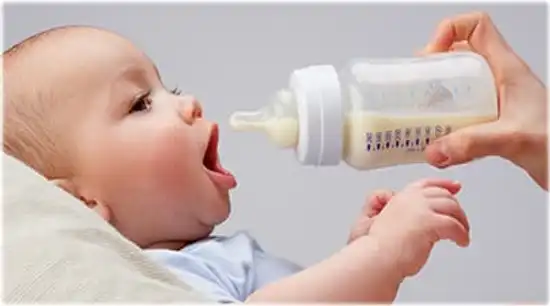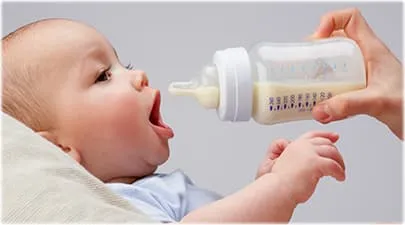Bottle-Feeding Myths and Facts

Adding 2 ounces of water to powdered formula is the same as adding:
2 tablespoons of water
1/4 cup of water
1/2 cup of water
Adding 2 ounces of water to powdered formula is the same as adding:
Most powdered formula calls for one level scoop of powder to 2 ounces, or 1/4 cup, of water.
Don't eyeball it. Adding too little water could leave your baby thirsty. Adding too much can cause seizures and may not give them enough calories for proper nutrition.

After mixing powdered formula, how long can you leave it at room temperature?
8 hours
Up to 2 hours
Less than 1 hour
After mixing powdered formula, how long can you leave it at room temperature?
Once you mix formula, you should feed it to your baby or refrigerate it within 1 to 2 hours. If it's been sitting out for more than 2 hours, throw it out. And throw out any formula they don't finish drinking.
You can store prepared formula in the refrigerator for 24 hours and open containers of ready-made or concentrated formula for 48 hours in the fridge too.

To warm a bottle of formula evenly, put it in the microwave.
True
False
To warm a bottle of formula evenly, put it in the microwave.
Microwaves don't heat evenly, so the formula could burn your baby's mouth. To warm a bottle safely, run it under hot water or put it in a pan of hot water for a few minutes. Shake the bottle and squirt a little on the inside of your wrist to make sure it's lukewarm. Or see if they like formula cold or at room temperature -- that's even easier!

It may help your baby switch from breastfeeding to bottle-feeding if:
You try it at night, when they are sleepy and less likely to notice.
You try it in the place where they usually breastfeed.
Someone besides Mom offers the bottle.
It may help your baby switch from breastfeeding to bottle-feeding if:
The switch is likely to go smoother if they don't have the usual clues telling them it's time to eat. Have someone else give the bottle in a place that won't remind them of breastfeeding.
This is a great time for your partner or a new caregiver to get involved.

Spitting up may mean:
They drank too fast.
They are uncomfortable.
You need to switch to a different formula.
Spitting up may mean:
Babies spit up! That's normal. It's not like vomiting, which is more forceful and can upset your baby.
Check the size of the hole in the bottle's nipple. If it's too big, they may be drinking too much milk or formula. If it's too small, they might be gulping in air. When you hold the bottle upside down, just a few drops should come out. If it's more or less, you may want to try a different nipple.

After their first month, a bottle-fed baby usually takes in about:
1 ounce every hour
2 ounces every 2 hours
4 ounces every 4 hours
After their first month, a bottle-fed baby usually takes in about:
By 6 months, it may be more like 6 to 8 ounces, four or five times a day. Those are just averages. Your baby may be different. Your doctor will let you know at wellness visits if they are eating too much or too little.

Avoid iron-fortified formula. It causes constipation.
True
False
Avoid iron-fortified formula. It causes constipation.
You may have heard that babies who drink low-iron formula have softer poop. But even iron-fortified formula has only a little iron -- enough to prevent anemia and help your baby grow well, but not so much that they get constipated.
Low-iron formula doesn’t give babies enough iron. The American Academy of Pediatrics advises that all bottle-fed infants drink iron-fortified formula until age 1.

In a pinch, it's OK to bottle-feed your infant cow's milk.
True
False
In a pinch, it's OK to bottle-feed your infant cow's milk.
Never give your baby cow's milk before the age of 1. Cow’s milk can stress a newborn's kidneys, can cause intestinal bleeding, and might cause anemia.
Formula has added nutrients that infants need. After one year, they can drink whole milk.

You don't need to boil baby bottles and nipples after every use.
True
False
You don't need to boil baby bottles and nipples after every use.
Just wash bottles, nipples, and caps in hot, soapy water before you use them for the first time, and then after every feeding. Also, make sure you wash your hands before you feed your baby.

You can't bond with your baby during bottle-feeding like during breastfeeding.
True
False
You can't bond with your baby during bottle-feeding like during breastfeeding.
When you give your baby a bottle, you can make it a warm, loving experience. Hold them closely so they look at you while they feed. Look into their eyes and coo and talk gently. For skin-to-skin time, undress your baby to their diaper. Cuddle them to your chest, with their head just under your chin while you feed. Put a blanket over them to keep them warm.